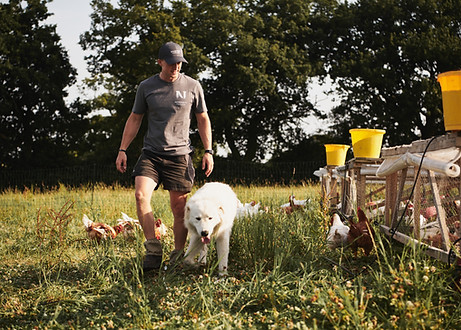Nempnett Chicken
Naturally grown / Pasture Raised / Doing what chickens do

micro poultry production
Chicks
All of our day-old chicks start their life in the brooder, where they are kept nice and warm, around 32c. When the birds are around 3 weeks old, they should be big enough and have enough feathers to keep them warm outside; this is when we move them completely outside on our natural, diverse, chemical-free pastures.
The Chicken Tractor
This is a 'Pasture Raised' model, which means there are no fixed buildings or ranges! They live in small groups out on pasture, in portable shelters (we call them chicken tractors!). These shelters are floorless and propped up on wheels allowing them in our out whenever they please day and night.
They get moved daily to fresh ground, enriching the birds with unlimited natural sunlight, lots of fresh air, fresh pasture, bugs and insects to forage on. We believe this goes above and beyond the standard 'Free Range' model.
When the grass gets too long for the chickens we bring in our herd of cows to graze it down, leaving some amazing cow pats full of bugs for the chooks to scratch through.
Livestock guardian dogs
Our birds wouldn’t stand a chance living as naturally as this without the protection from Bear and Holly our two livestock guardian dogs. These dogs are Maremmas and were bred in the laps of Italy to protect flocks of sheep from wolves and other such predators, turns out they do a great job protecting poultry too, allowing us to keep them completely outdoors 24-7, yes even at night! If you have a predator problem bring in a bigger predator!




Additional Fed
Chickens have a mono gastric digestive system which means they can't live from grass alone so we also feed them additional cereals; 80% of which come from a local farm just down the road and get's milled and mixed on the farm. This is a high-quality feed free from any antibiotics and growth hormones. All of our poultry finisher feed is free from soya and sourced as locally as possible.
Slow Grown
They are grown slowly for another 7-9 weeks, enjoying the pasture, bugs and cow pats, this lets them develop naturally, stressless and happy; reaching maturity the way chickens should.
It's this slow growth, pasture foraging and high health of the birds that gives them amazing flavour and texture to their meat and a golden, yellow colour to their skin. In fact the golden yellow skin comes from the beta carotene found in chlorophyll in grass, it's the same reason 100% grass fed beef has yellow fat. The yellower the fat the better!
Their 'one bad day'
When they are 10-12 weeks old, nearly twice the age of standard chicken, they have their 'one bad day'. Luckily this only involves a short 18 mile journey to a local, family run poultry processing facility, where they get slaughtered and processed, all under the watch of a ministry vet to make sure everything happens how it should.
As soon as we get the processed chicken back to the farm it is put straight into our commercial freezer. This locks in and preserves the quality of the fresh bird, when defrosted slowly, you are left with a great quality pasture raised chicken.
Enhancing the farm
Our chicken enterprise works in harmony with the other enterprises on the farm, increasing diversity and building soil. Because our coops are modular and mobile we can move them to any location on the farm that would benefit from some free fertility, in the form of chicken poop! We love to see different enterprises sharing the land each bringing its own benefits to the soil health and biology, the way nature intended.

Benefits of 'Pasture Raised'
Moving onto fresh pasture every day has many benefits; animal welfare is a major one, the daily fresh patch of pasture gives them a new world to explore every day, with fresh grass and bugs to eat. All of their dung from the day before will be left behind to get broken down by dung beetles and other insects; feeding the soil biology to grow more grass that we can then feed to our cows.
No fixed sheds! Wild animals are always on the move, never to be found in the same place for any length of time. This is what we are trying to replicate using small, mobile shelters and temporary fencing. We can effectively move our birds anywhere on the farm. Moving regularly keeps the soil covered and the land fresh, evenly spreads manure and contains no dust!
Moving to fresh ground also stimulates the birds to express their natural behaviour, foraging for grasses, weeds, insects and worms, scratching out new dust baths and/or just having a sleep in the sun.
